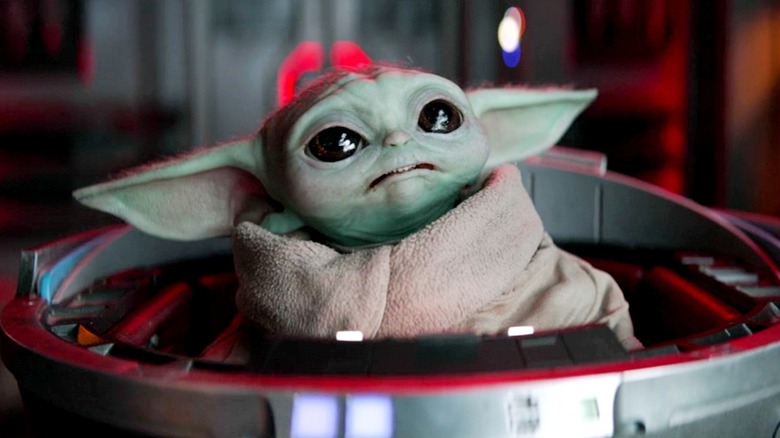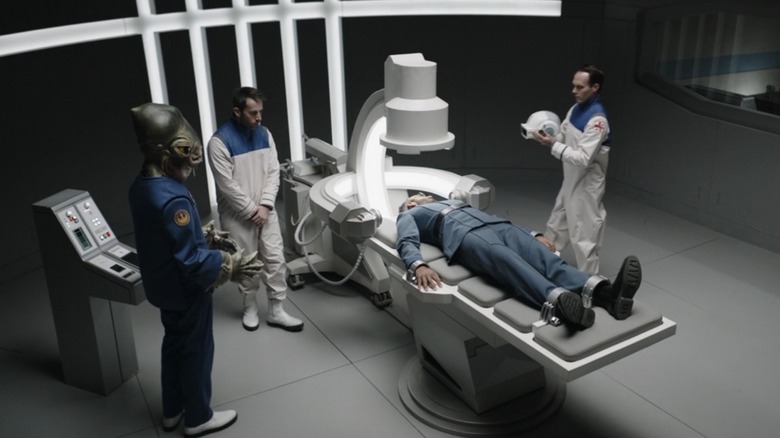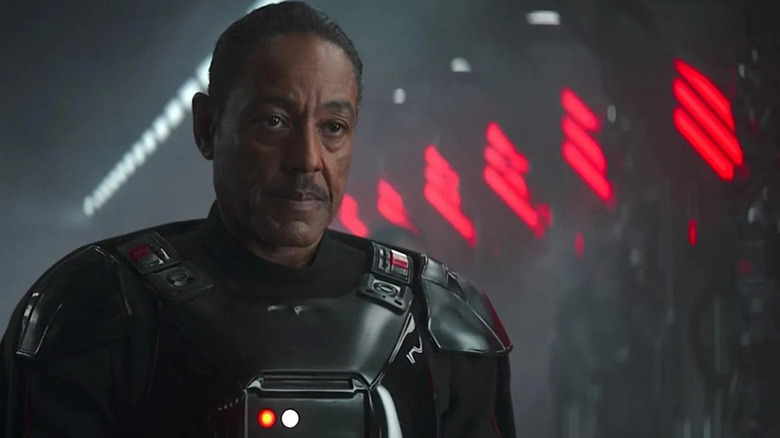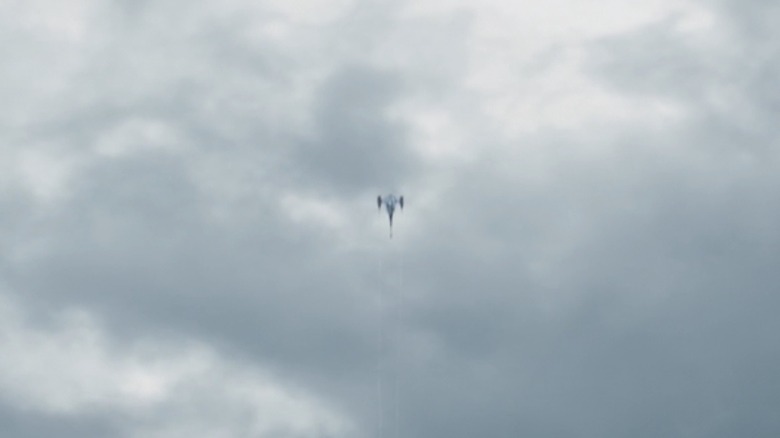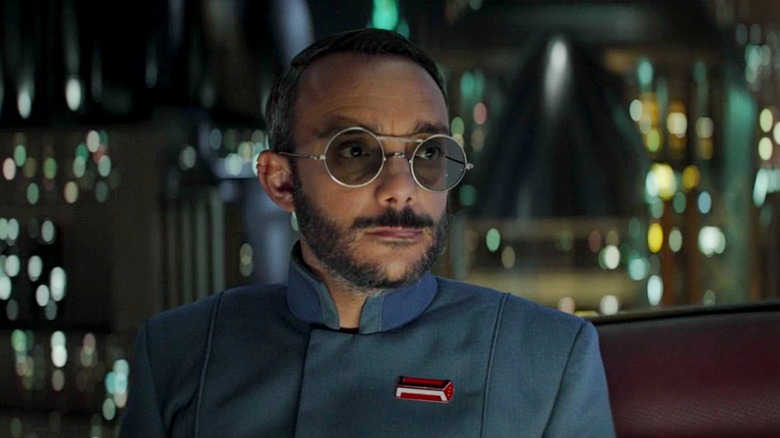The Mandalorian Season 3 Episode 3 Takes A Right Turn Toward Coruscant
This post contains spoilers for the latest episode of The Mandalorian.
"The Convert," the third episode of the third season of "The Mandalorian" and the nineteenth installment of the show overall, takes a hard left turn at Coruscant and follows intrigue that will likely lead us to Moff Gideon later in the season.
The episode begins with Lady Bo-Katan Kryze of Clan Kryze (Katee Sackhoff) having just pulled Din Djarin (Pedro Pascal, et al) from the Living Waters of Mandalore. Din regains consciousness and she asks him if he saw anything living down there. When he says he didn't, she keeps the information about the mythosaur they saw in the last episode to herself.
As they leave Mandalore, successful in their mission to redeem Din Djarin, they head back to Bo-Katan's castle only to find it under attack from Imperials. What Imperials? And how do they have so many TIE Interceptors and TIE Bombers? It's a mystery. So Din Djarin sends Bo-Katan coordinates to a safe place and they escape by the skin of their teeth.
The episode then shifts to focus on Dr. Pershing (Omid Abtahi), the cloning scientist pressed into service by Moff Gideon. He's in the New Republic Amnesty program and trying to do everything he can to help the New Republic, though the cloning and genetic research he did before are prohibited under the Coruscant Accords. In his Amnesty Housing, he runs into a former communications officer from Moff Gideon's ship, Elia Kane (Katy M. O'Brian), and the two of them form a fast friendship. As they talk, she convinces him that he should keep on with his experiments, even though it would get them kicked out of the Amnesty program. She takes him on an adventure outside of their permitted zones to a decommissioned Imperial Star Destroyer to steal lab equipment so he could keep pressing on with his science.
Unfortunately, Kane is something of a triple agent. Working for the New Republic, she turns Pershing in and gets him sent right to a "mind-flayer." Here, they'll electronically remove bits of his memory. Revealing herself as a darker instrument who has not recanted her ways, she manipulates the machine to do a lot worse to Pershing, presumably wiping his work for Moff Gideon from his mind completely.
Then, we turn back to the story of the Mandalorians. Din Djarin and Bo-Katan Kryze arrive at the secret Mandalorian Covert from the first episode of the show. Paz Vizsla has no interest in letting Din or Bo-Katan — both apostates — enter the covert, but they bring proof that they bathed in the Living Waters. The Armorer welcomes them both to the covert, redeemed for their apostasy and Mandalorians once again.
Brazil
One of the coolest things about this episode is how many touchstones it has to Terry Gilliam's "Brazil." I wrote about how it influenced "The Last Jedi" as well, and it's great to see it getting more play in "Star Wars." In this episode, it comes very much in the form of Dr. Pershing's experience in the job he's been given during his amnesty. He's just going through sets and sets of data cards (all of them looking very much like the data cards Princess Leia used to smuggle the Death Plans in "Rogue One: A Star Wars Story" and "A New Hope). He realizes that so much of what he's going through is stuff that's ready to be decommissioned, even though it could still be useful to the New Republic. There's a moment when he wants to rescue a particular piece of equipment and his supervisor tells him he would need to file a C-1023, which smacks a lot of the 24B-stroke-6 in "Brazil" and "The Last Jedi." More than anything, there's a futility to the bureaucracy in "Brazil" that feels like the New Republic is falling into that trap.
The other major moment that feels very much like "Brazil" comes at the end of Dr. Pershing's story. He's captured, much like Jonathan Pryce's Sam Lowry, for trying to do what is ostensibly the right thing. Pershing can save lives through the ethical application of his research, and he's led to believe that he can do it. But he's captured and sent to be re-educated. In "Brazil," Lowry discovers his old friend, Jack Lint (Michael Palin), is the government torturer assigned to reeducate (or kill) him. Here, Pershing can't tell friend from foe, but knows that this will destroy his mind. The tech assures him that it's all at a low voltage and will just help him get back to being himself.
It's only when Elia Kane turns up the voltage do we realize exactly who she's working for and what she's likely been sent to accomplish.
It's a bleak ending, just like "Brazil" and it just goes to show how corrupt even the most well-meaning of bureaucracies can become if they're manipulated by the wrong people in the wrong ways.
Moff Gideon
This episode has a compelling case for the idea that Moff Gideon will be a central villain in this season of the show (or possibly even the next.) Early on, when Pershing, Kane, and other former Imperials share a drink, they also share rumors of Moff Gideon's potential escape from New Republic hands.
As Elia Kane's story unfolds and she makes her shocking turn at the end, it becomes very apparent that Gideon is who she's pulling the strings for.
The bigger question, then, is why?
We still have very little idea of what Moff Gideon was really up to. We don't know what he's consolidating his power for. Are those his TIE Interceptors that destroyed Bo-Katan's home? Is there some larger Imperial Remnant he's rallying? Is Gideon actually working for a returned Thrawn and we'll find out about that in the "Ahsoka" series?
These are all tantalizing questions raised by this single episode, set on Coruscant.
When will he rear his head again?
Details to watch out for
There are so many little nods in this episode that it's difficult to track them all.
As Din Djarin and Bo-Katan battle the TIE Interceptors, there's a moment with the N1 Starfighter that looks as though it was pulled straight out of Tim Burton's "Batman" (1989). Din Djarin pulls straight up into the air with his N1, leaving the silhouette of the ship to hang in the sky for just a moment before descending back down on his enemies. It hearkens back to that moment when the Batwing is framed against the moon in the night sky during the penultimate climax in Tim Burton's superhero masterpiece.
Then, we set the stage on Coruscant, the former capital of the Republic. For those folks hoping to see Mon Mothma or any of the inner workings of the government, it's important to note that Coruscant is not the capital in this era of the New Republic. That honor goes to Mon Mothma's home planet of Chandrila. After that, other planets hosted the capital until it landed on Hosnian Prime at the time of "The Force Awakens," when it was destroyed by the First Order's Starkiller base. Coruscant was one of the last planets to fall to the New Republic after Mas Amedda signed an instrument of surrender well after the Battle of Jakku. You can read all about that in Chuck Wenig's "Aftermath" books.
On Coruscant, there are some familiar sights. Chief among them is the opera house that Dr. Pershing is speaking in at the beginning of the episode. It's the same one where Anakin Skywalker and Sheev Palpatine had their discussion about midi-chlorians and Darth Plagueis in "Revenge of the Sith."
Monument Plaza is a location we've heard a lot about but have never seen in close detail in live action. The peak of Umate, the highest mountain on Coruscant, features at the center of the plaza and Pershing and Kane have a touching heart-to-heart there. It's featured in media from "The High Republic," "The Clone Wars," and Chuck Wendig's "Aftermath." We glimpse it in "Return of the Jedi" for the barest of seconds. It's an important spot on Coruscant and it's good to be getting a better look at it. The music here is also very familiar. It sounds like they've adapted John Williams' "March of the Resistance" to play here, which is a very interesting choice of theme here.
The bus Pershing and Kane get on also feels very much like the transport Padmé and Anakin take to get to the refugee ship in "Attack of the Clones."
Other locations on Coruscant are mentioned, including the Skydome Botanical Gardens, which come right out of old Legends material.
The last thing I'll point out: the days of the week that get called out in the episode. Benduday is the equivalent of Friday in a galaxy far, far away, named after the Bendu monks that were an early precursor to the Jedi Order on Coruscant. Whether they're related to the Bendu that was voiced by Tom Baker in "Star Wars Rebels" is up for debate. Taungsday is the third day of the week in the galactic calendar, and weeks in "Star Wars" are 5 days long, not 7. All of these days have an obscure origin in a magazine series published between 2014-2016 by DeAgostini that came with replicas of pieces of the Millennium Falcon.
Coda
This episode is not going to be everyone's favorite. It takes a hard right turn into another story, though I think that story is going to pay dividends in the future of the season. It is vitally important to see how someone like Moff Gideon can hold onto power, even in the midst of the New Republic. His hand casts a shadow over everything that happens on Coruscant in this episode.
Having said that, it sows so many seeds in the continuing story of Bo-Katan and Din Djarin, too.
The episode title refers as much to Dr. Pershing trying to be a convert into the New Republic as it does to Bo-Katan's new status among the adherents of the Path in the Mandalorian covert. She keeps the information about the mythosaur to herself. Is that because she's questioning her reality? Or because she doesn't trust Din and wants to use it to her advantage. At the end of the episode, she focuses in on a mythosaur skull hanging in the covert and it offers us no more clues into her intentions than we had before.
More than anything, this episode feels as though it's dropping vital pieces of story in place for future episodes. Will Gideon be the threat the different sects of Mandalore are able to unite against to become a people once more? Or will they continue their petty squabbling?
As much as this episode satisfied my prequel-loving heart, it shows the cracks in what the special effects are able to accomplish on the show. Yes, they have the stagecraft, but Coruscant is still a really complicated environment to pull off. I think they did so reasonably well, but I can definitely see where it might strain credulity for some viewers. There's also something to be said about this episode feeling like a side story. For viewers not accustomed to putting two and two together for themselves, I can see where they might feel Dr. Pershing's story simply isn't relevant. They're wrong, but I can feel where they might sense that.
It's a really bold move to take this turn in the series, even just for an episode. I think it's going to pay off later as we dive deeper into the Living Waters and explore what it actually means to be a Mandalorian. This episode asks a lot of questions we don't have answers to, and it will be judged a lot more fairly (or harshly) based on how those answers turn out. Which, in my mind, makes it a very successful piece of episodic television.
"Star Wars: The Mandalorian" is streaming only on Disney+. New episodes come every Wednesday.
